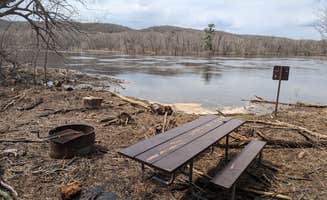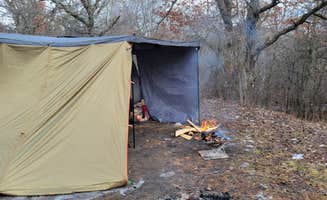South of Sand Dunes State Forest offers primitive camping near Landfall, Minnesota on gravel roads traversing sandy terrain. Located within a managed forest zone, the area features a distinctive mix of pine stands and open areas with varying accessibility depending on seasonal conditions. Summer camping has a 14-day limit while cooler seasons allow stays up to 21 days.
What to do
Wildlife observation: The forest contains diverse bird species and wildlife. "There's lots of little spots off the main gravel road. Nothing allowed further into the forest... Sand storks are very protective. Stay away from them. They attack," notes Heather W. about the area's natural residents.
Hammock camping: The forest layout provides ideal hammock spots between trees. "I was able to walk in and find an incredible spot to camp and lay in my hammock," shares Joslyn H., highlighting the relaxation opportunities in the area.
Hiking nearby trails: The region connects to various recreational paths. Along the Ice Age Trail at Sandy Cove on the St. Croix River, "Well managed gravel trail to the south and single wide footpath to the north" provides walking options, according to Travis B.
What campers like
Proximity to urban areas: The forest provides backcountry camping close to population centers. "I love that it's so close to home," notes Joslyn H. about this rustic camping option near the Twin Cities.
Peaceful environment: Most campers report minimal disturbance, especially during weekdays. "Came back on a warm weekend. A bit more traffic, but after 12 p.m., not much of anything. I really recommend this for an easy stop if you're looking for a place to put up. It's peaceful and tons of spots to park," writes Skip H..
Natural soundscape: The forest offers an acoustic retreat from urban noise. "This is a nice quiet area. Some younger people coming through sporadically playing with their trucks but nothing serious and not often," reports Jason B., adding it has "lots of different bird sounds."
What you should know
Road conditions: The forest roads accommodate standard vehicles but require caution. "I stayed here for one night and roads were totally fine for any vehicle," notes Samuel C., though he adds there are "limited spots that are big-rig friendly."
Vehicle traffic variations: Forest road usage fluctuates by day and time. "Plenty of spots. Fairly small spots. This road is pretty busy for a dirt forest road and people FLY down it. Almost got hit a few times walking. Even through a Wednesday night cars are flying down the road," cautions Ryan P.
Rule enforcement: Local authorities monitor camping activities. "I had a county sheriff person tell me it's not lawful to park a trailer and they kicked me out. I called the DNR and they said that wasn't right but I decided to leave anyway," reports Jason B., indicating potential enforcement inconsistencies.
Tips for camping with families
Site selection considerations: Choose spots based on vehicle size and camping equipment. "Most sites are like the pictures shown. There are a few spots that have great views or pull-through areas," explains Samuel C., noting site variability throughout the forest.
Wildlife awareness: Prepare children for potential wildlife encounters. "Saw lots of dogs, and mine had a blast, even had what seemed to be a stray husky quickly roll through camp around dusk. Something to keep on your mind," warns Samuel C.
Accessibility concerns: Some areas have more challenging terrain. "Drove past several sites, most of which were by water. We did find one we thought we liked, but branches over hung, and rested on our camper (8ft high) and in fact most sites were shaded," describes Gregory.
Tips from RVers
Vehicle size limitations: The area best accommodates smaller campers and trailers. "Great spot. Plenty of parking. Best for straight vehicles or very small trailers," advises Skip H., emphasizing the compact nature of many sites.
Side road restrictions: Not all forest roads permit vehicle access. "The bad part a lot of the side roads are closed to motor vehicles due to some issues they had a couple years ago but are now taken care of like people dumping," explains Adam W., noting important navigation constraints.
Overhead clearance issues: Trees may impact taller vehicles. "Branches over hung, and rested on our camper (8ft high)," notes Gregory, describing challenges for RVs with significant height.



